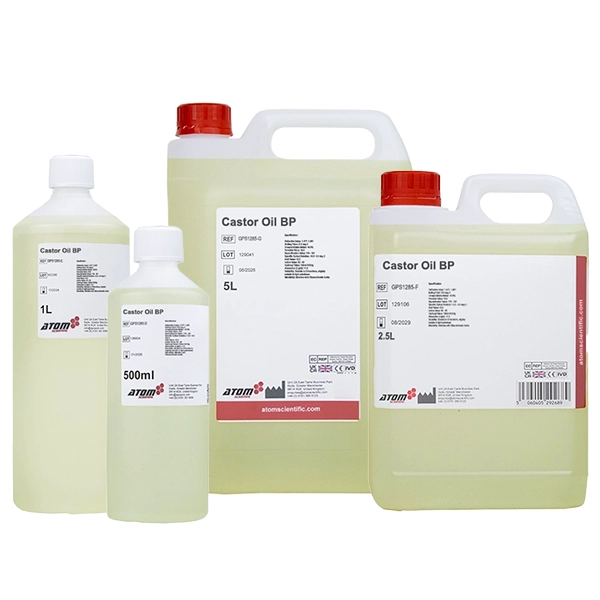Castor Oil BP

£5.57 to £153.60
| Variation ID | Pack Size | List Price | Qty | ||
|---|---|---|---|---|---|
| photo_camera | 100ml
GPS1285-B |
£5.57 | |||
| photo_camera | 250ml
GPS1285-C |
£6.89 | |||
| photo_camera | 500ml
GPS1285-D |
£7.99 | |||
| photo_camera | 1L
GPS1285-E |
£10.75 | |||
| photo_camera | 2L
GPS1285-2E |
£19.24 | |||
| photo_camera | 2.5L
GPS1285-F |
£21.34 | |||
| photo_camera | 5L
GPS1285-G |
£38.41 | |||
| photo_camera | 25L
GPS1285-K |
£153.60 |
What is Castor Oil? It is a vegetable oil pressed from castor beans, the seeds of the plant Ricinus communis. The seeds are 40 to 60 percent oil. It is a colourless or pale yellow liquid with a distinct taste and odour. Its boiling point is 313 °C (595 °F) and its density is 0.961 g/cm3. It includes a mixture of triglycerides in which about 90 percent of fatty acids are ricinoleates. Oleic acid and linoleic acid are the other significant components. Some 270,000–360,000 tonnes (600–800 million pounds) of castor oil are produced annually for a variety of uses.
Consistent Quality: We provide only high-quality Castor Oil, meeting the standards of British Pharmocopoeia (BP), ensuring reliable and consistent performance for all applications. Our Castor Oil is considered organic, and contains no Hexane nor is extracted using Hexane.
Shipped from Manchester, UK Facility: Sourced and bottled using non-toxic, chemical-resistant containers, ensuring reliable quality for our customers.
Frequent Uses
Food industry
In the food industry, food-grade castor oil is used in food additives, flavourings, candy (e.g., polyglycerol polyricinoleate in chocolate), as a mold inhibitor, and in packaging.
Cosmetics
Utilised in cosmetic products included in creams and as a moisturiser. It is often combined with zinc oxide to form an emollient and astringent, zinc and castor oil cream.
Pharmaceutical
Employed as an excipient for serums administering steroid hormones such as estradiol valerate via intramuscular or subcutaneous injection.
Lubricants
Castor oil has better low-temperature viscosity properties and high-temperature lubrication than most vegetable oils, making it useful as a lubricant in jet, diesel, and racing engines.
Chemical precursor
Transesterification followed by steam cracking gives undecylenic acid, a precursor to specialized polymer nylon 11, and heptanal, a component in fragrances. Breakdown of castor oil in strong base gives 2-octanol, both a fragrance component and a specialized solvent, and the dicarboxylic acid sebacic acid. Hydrogenation of castor oil saturates the alkenes, giving a waxy lubricant. Castor oil may be epoxidized by reacting the OH groups with epichlorohydrin to make the triglycidyl ether of castor oil which is useful in epoxy technology. This is available commercially as Heloxy 505.
- Food preservative and mould inhibitor
- Moisturisers and creams
- Pharmaceutical excipient
- Soaps
- Lubricants
- Hydraulic and brake fluids
- Paints
- Dyes
- Coatings
- Inks
- Cold-resistant plastics
- Waxes and polishes
- Nylon
- Perfumes
PHARMACEUTICAL GRADE (BP)
This product is organic and there are no additives within.
FOOD GRADE
Suitable for Pharmaceutical and Cosmetic Applications
R.I.: 1.477- 1.481
B.P.: 313 °C
Unsaponifiable Matter: <0.8%
Peroxide Value: <5.0
Saponification Value: 176 - 187
Specific Optical Rotation: +3.5 - 6.0 deg C
Acid Value: <2.0
Iodine Value: 82 - 90
Hydroxyl Value: 150ml KOH/g
Absorption (Light): <1.0
Solubility: Soluble in Chloroform, slightly soluble in light petroleum
Miscibility: Miscible with ethanol/acetic acid
Cas Number: 8001-79-4
Einecs Number: 232-293-8
HS Code / Commodity Code: 1515300000
Hazard Phrases: H0001










